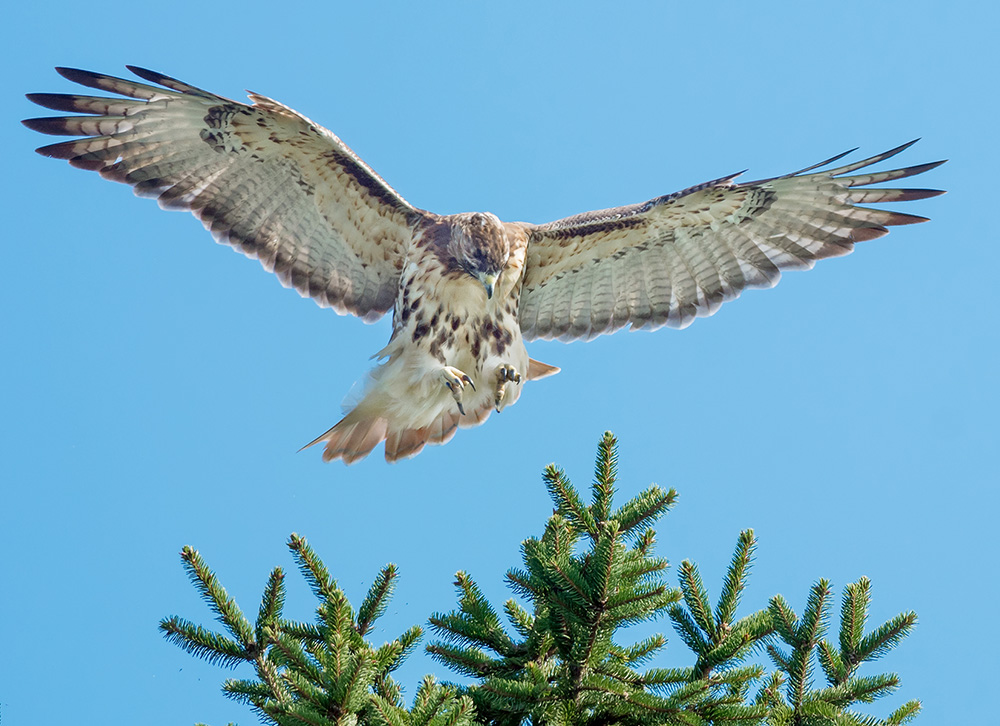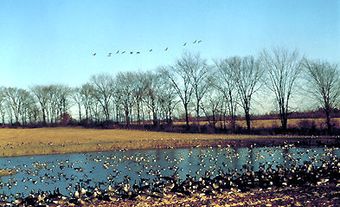A bird wing is an airfoil combining the functions of an aircraft wing and propeller blade to give lift and thrust. It is radically modified from the vertebrate arm for strength and lightness. The upper and forearm bones are elongated, joined by a feather-bearing membrane, and support secondary flight feathers. The wrist and hand bones are fused (some are lost entirely), and support the primary flight feathers.
Wing evolution has been affected by the habitats to which birds have adapted (e.g. the open ocean, cliff tops or the closed environment of forests) and by the need to reduce drag, or air resistance. Wing shape and size have been modified to reduce drag and to enable the bird to achieve the most advantageous kind of flight in its usual habitat.
The relationship between the wingspan and the average width of the wing, called the "aspect ratio," also varies. It is calculated by dividing wingspan (tip to tip) by the average width of wing. The long, narrow wings of oceanic soarers have high aspect ratios, enabling these birds to sustain flight over long distances without flapping, and consequently reducing energy expenditure.
The tail is not a rudder, but a combined landing flap and elevator. It is spread and lowered at landing, the wing being pulled forward to keep the centre of pressure above the centre of gravity. In turning, the bird banks through unequal lift on the wings, and raises the tail.
Wing Forms
Birds soar (without flapping), hover (with wings beating backward and forward in configurations resembling the figure 8), or achieve fast, level flight (wings beating rhythmically up and down). Wing forms correlate closely with these types of flight, and 4 slightly overlapping wing types can be identified.
Wing Action
Most birds have a relatively slow, powered downstroke and a fast, neutral upstroke with the wing partly folded. Swifts and hummingbirds have very rigid wings that supply lift and thrust on the downstroke, thrust on the upstroke or lift if hovering. Short wing bones and a massive tendon anchoring the hand prevent sagging at the wrist. This rigidity distinguishes the flight of a swift from the fluid action of a swallow.
In most sandpipers and related waders, there is a normal downstroke; then, by increasing the angle of attack, the spread wing is lifted more slowly, giving lift and saving muscle power at the cost of some added drag. When a wing is pulled forward to its limit, complex changes in form affect its behaviour.
Soaring is essentially gliding in an updraft. The main updrafts are mechanical, as when a wind blowing against a ridge forces air aloft; and thermal, as when cylindrical updrafts are formed on sunny days. Thermals are strongest over dark and dry surfaces such as in ploughed fields. Birds become adept at detecting reduced lift on the outer wing tip, and thus spiral within the thermal.
Elliptical Wing
The elliptical wing, with a slightly asymmetrical curve, gives good manoeuvrability and nearly even pressure distribution. With minor variations it is seen in most bats, perching birds and other birds of closed habitats in which long primary feathers would soon fray. The aspect ratio is usually 4.5-6.
The house sparrow has the aerodynamics of a WWII Mk5 Spitfire. Such wings have a large alula (thumb-wing) forming a midwing slot, and several outer primary feathers forming tip slots, all giving extra lift. The Jurassic bird Archaeopteryx had a well-formed but unslotted elliptical wing. It lacked power in flight but was a competent glider. The gray catbird, which favours dense shrubbery, combines very short wings with ample slotting. Moderately fast, flapping wing beat is usual to this wing type.
High-Speed Wing
The high-speed wing is unusually flat, tapering to a narrowly elliptical tip. It has a smooth outline which blends the trailing edge of the wing into the body, thereby reducing turbulent drag. Its aspect ratio is moderately high (i.e. wings are relatively long and narrow). The high-speed wing has a pronounced sweepback, which reduces drag. This wing type has evolved independently in ducks, falcons, most plovers, swallows, swifts and hummingbirds. Flapping is constant with a rapid beat; specialization allows high flight speed, and relatively low energy expenditure. No wing slots are present.
High-Aspect-Ratio Wing
This type of wing is best developed in oceanic soarers (notably albatrosses), which are seldom on land except when nesting; they launch from cliffs with little or no beating, and are almost immune to feather damage. This long, slender, pointed wing allows soaring at high speed with low energy expenditure. Wingspan can reach 5 body lengths. The aspect ratio is about 8 in gulls, and up to 15 in albatrosses.
Slotted Soaring or High-Lift Wing
This wing type is seen in birds of prey. Specialization allows soaring at low speed, and enables the bird to take off and land in confined areas. The aspect ratio is about 6-7, as high as nesting and hunting terrain permits. Lift is increased by extensive square-based slots. The lift from wing-tip slots shows in the upcurved primary feathers of a soaring raptor.

 Share on Facebook
Share on Facebook Share on X
Share on X Share by Email
Share by Email Share on Google Classroom
Share on Google Classroom






